When I graduated University with a business degree last May, I received two incredible full-time job offers, both of which I declined because I had a plan. For exactly one year, from May 1, 2013, through May 1, 2014, I would devour everything I could get my hands on about productivity, and write every day about the lessons I learned on A Year of Productivity. Over the last 12 months I have conducted countless productivity experiments on myself, interviewed some of the most productive people in the world, and read a ton of books and academic literature on productivity, all to explore how I could become as productive as possible, and then write about the lessons I learned. One year, 197 articles, and over one million hits later, I’ve reached the end of my year-long journey, but not before going out with a bang. This article’s a long one, but it’s pretty skimmable! Without further ado, let’s jump in. To kick things off, here are a number of my favorite time hacks to both: Hacks to get more time
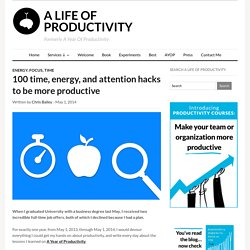
A Life of Productivity – 100 time, energy, and attention hacks to be more productive
How to Prioritize Work: 7 Practical Methods for When "Everything is Important"
One of the biggest struggles in the modern workplace is knowing how to prioritize work. Workloads are ballooning and everything feels important. However, the truth is that a lot of the work we do every day doesn’t really need to be done. Learning how to prioritize means getting more out of the limited time you have each day. But while the elements of prioritization are simple (i.e. To make things easier, we’ve collected some of the best strategies out there on how to prioritize work into one master list. RescueTime tells you exactly how you’re spending your time every day so you can prioritize the work that matters most. 1. Prioritization happens on different levels. Unfortunately, those lists don’t always match up. Start by making a master list—a document, app, or piece of paper where every current and future task will be stored. Once you have all your tasks together, it’s time to break them down into monthly, weekly, and daily goals. 2. In some cases it will come down to experience.
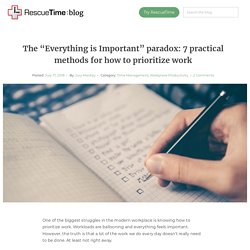
Productivity
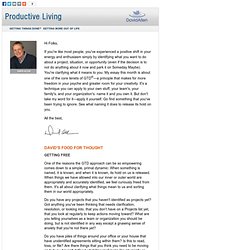 Hi Folks, If you're like most people, you've experienced a positive shift in your energy and enthusiasm simply by identifying what you want to do about a project, situation, or opportunity (even if the decision is to not do anything about it now and park it on Someday Maybe). You're clarifying what it means to you. My essay this month is about one of the core tenets of GTD®—a principle that makes for more freedom in your psyche and greater room for your creativity. It's a technique you can apply to your own stuff, your team's, your family's, and your organization's: name it and you own it. All the best, Getting Free One of the reasons the GTD approach can be so empowering comes down to a simple, primal dynamic: When something is named, it is known; and when it is known, its hold on us is released. Do you have any projects that you haven't identified as projects yet? Do you have piles of things around your office or your house that have unidentified agreements sitting within them? —unknown
Hi Folks, If you're like most people, you've experienced a positive shift in your energy and enthusiasm simply by identifying what you want to do about a project, situation, or opportunity (even if the decision is to not do anything about it now and park it on Someday Maybe). You're clarifying what it means to you. My essay this month is about one of the core tenets of GTD®—a principle that makes for more freedom in your psyche and greater room for your creativity. It's a technique you can apply to your own stuff, your team's, your family's, and your organization's: name it and you own it. All the best, Getting Free One of the reasons the GTD approach can be so empowering comes down to a simple, primal dynamic: When something is named, it is known; and when it is known, its hold on us is released. Do you have any projects that you haven't identified as projects yet? Do you have piles of things around your office or your house that have unidentified agreements sitting within them? —unknown
Productive Living

Organise Me: Desk Space , Organise Me
By Andrea McArthur It seems we all need a little help when it comes to creating our perfect desk space. In order to create a functioning work space here are a few great tips from Renée Rogers and Jess Hyde to keep your desks looking as welcoming as theirs. Tip #1: Keep your reference files at hands reach. Above: Renée’s Desk Renée Rogers is a Graphic Design Lecturer at Shillington College with a secret love of English Monarchy promotional ceramics. In the photo of Renée’s desk it is set up in preparation for week one of her new course. Tip #2: Clean up and finish your tasks, everything has a place. Above: Jess’s Desk Jess Hyde is a multi-talented Graphic Designer and Illustrator, she is the founder of truth.be.told stationery which began in 2007. We asked Jess what her secret is to staying organised in the office and her work life. Tip #3: Work with the correct tools around you. Above: Andy’s Desk Andrea McArthur has a passion for all things visual and a soft spot for organisation.
7 Things “Star Wars” Taught Me About Productivity
A few weeks ago Cheryl Richardson, author of the book “The Art of Extreme Self-Care,” asked what movie had impacted me the most. I jumped right up and said “Star Wars,” because I believe in The Force. And I’m not the only one. In 2001, “Jedi” became the fourth most popular religion in the United Kingdom. I saw the original Star Wars when I was seven years old and it changed my life. Here’s some of the life lessons that I’ve learned from the Star Wars movies: 1) Rest when you have nothing to do. When Jedi Qui-Gon Jinn is fighting Darth Maul in The Phantom Menace, a transparent door closes, dividing them (see in video above). In modern society we all feel like we have to be like Darth Maul. 2) Rid yourself of everything you don’t need. Obi-Wan lives a simple life in exile for 40 years when he’s on Tatooine. 3) Practice being “good.” Being a good, compassionate person is a quality we develop over years and thousands of hours of practice. Supposedly it takes 10,000 hours to master something.
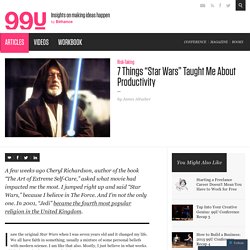
Productivity is About Constraints and Concentration
The fact that there is only so much time in a day is a sobering thought. Many times we are left scratching our heads after a long day wondering, “what did I even get done today?”. Saying “No” The one thing that everyone benefits from is the value created when we’re all doing our best work. The biggest hinderance to doing our best work is interruption and lack of focus. The Critical 3 The best way to get your best work done is to spend as much uninterrupted time as possible working at your craft. Set Constraints Ahead of Time It is always best to be honest with the people we serve and set constraints ahead of time, otherwise Parkinson’s Law (tasks will fill the time we allot for them) will kick in and we’ll automatically fill all of our time with mundane conversation and back-and-forth emails. If you allow instant access to your time, you will inevitably be interrupted. Have you ever known a salesperson that only spent one hour a day selling? Focus Focus is a funny concept. Conclusion
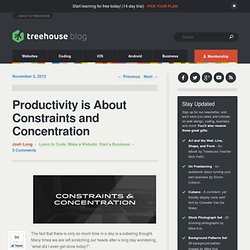
Parkinsons Law: How to complete tasks in optimal time Simply put the idea is work expands so as to fill the time available for its completion. This means that if you give yourself two weeks to complete a four hour task then the task will psychologically become more complex and become more daunting so as to fill those two weeks. The time may not be filled with extra work per se, rather the stress and tension about having to get it done will increase. In order to avoid this trap you need to assign an optimal amount of time to complete a task in order to avoid this increase in complexity. This is why some people work better with deadlines. Keep this in mind when planning your tasks. The Never Ending to-do list When you don’t prioritize your tasks everything seems crucial and important. The most productive people seem to always have 1 to 3 key prioritized tasks to complete before the day even starts. Being Wired in: Working in highly focused bursts Results peak with an optimum amount of time.
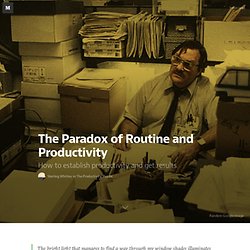
The Paradox of Routine and Productivity — Best thing I found online today
How We Work: Adam Dachis' Favorite Gear and Productivity Tricks
How We Work: Adam Dachis' Favorite Gear and Productivity Tricks
Use the Two Minute Rule to Stop Procrastinating and Get Things Done
Setting priorities: the key to effective time management
We are living in a time where there are a wide variety of things competing for our attention. Time is our most precious resource but it is limited. It is easy to spend our time responding to the tasks which seem most urgent but this is unlikely to lead to long term fulfilment. Thinking about the future can be a useful tool when setting priorities. The amount of time we spent in work? The above are all superficial issues which do not lead to personal fulfilment. For help mastering your time management, check out Quick Fixes for Your Productivity. Once we have identified our long term goals (i.e. what we would like to be remembered for) we can then work backwards to identify goals for the next 10, 5, 3, 1 years etc. Signing you up! Say Goodbye to Stress FOREVER! ...with 52 time management tips. Join thousands of subscribers and receive Stress management and performance tips to your inbox - FREE! Tell us your Name and Where to send your FREE eBook? We hate spam just as much as you

For the past few years, I’ve had the privilege of working with some of the most creative and inspiring people—designers. By design, I mean namely graphic, industrial, and architectural designers, plus a sprinkle of UI/UX folks from personal ties. They are the tinkers. The doers. The “how can this be better?” questioners. 1. Arguably the ultimate test of successful design, we too should be driven by bringing clarity to an objective, situation, or solution. Seeking clarity also means knowing when to raise your hand when you need help. 2. Once you know what you want to solve, design hierarchy is about prioritization. To help me prioritize, I try to employ the 2-minute rule: if a task can be completed in less than 2-minutes, do it immediately. 3. Designers have a love/hate relationship with constraints—but the outcome is always more impressive with them. Growing up in an immigrant family, I quickly learned the value of a good deal. Whatever life throws at you—embrace the challenge. 4. 5.

5 Design Principles for Life
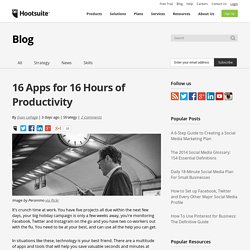 It’s crunch time at work. You have five projects all due within the next few days, your big holiday campaign is only a few weeks away, you’re monitoring Facebook, Twitter and Instagram on the go and you have two co-workers out with the flu. You need to be at your best, and can use all the help you can get. In situations like these, technology is your best friend. 7 a.m. You wake up in the morning and you check your phone. Email is one of the biggest time sucks for almost every human being with a computer. 8 a.m. Traffic is brutal this morning so you decide to take public transit into work. UberConference lets you start conference calls instantly on your phone. By the time you get to work, you’ve already sat in on an important call and have a recording you can use for notes when you’re not so busy. 9 a.m. You’re a social media manager, so the first thing you do when you get to work should probably involve social media. Why choose? Be more productive with social media 10 a.m. 11 a.m.
It’s crunch time at work. You have five projects all due within the next few days, your big holiday campaign is only a few weeks away, you’re monitoring Facebook, Twitter and Instagram on the go and you have two co-workers out with the flu. You need to be at your best, and can use all the help you can get. In situations like these, technology is your best friend. 7 a.m. You wake up in the morning and you check your phone. Email is one of the biggest time sucks for almost every human being with a computer. 8 a.m. Traffic is brutal this morning so you decide to take public transit into work. UberConference lets you start conference calls instantly on your phone. By the time you get to work, you’ve already sat in on an important call and have a recording you can use for notes when you’re not so busy. 9 a.m. You’re a social media manager, so the first thing you do when you get to work should probably involve social media. Why choose? Be more productive with social media 10 a.m. 11 a.m.
16 Apps for 16 Hours of Productivity
Nulana Shortcuts 1.2 Productivity Software Review | Macworld
For power users, keyboard shortcuts are a must. Mac OS X’s own Keyboard pane of System Preferences serves well enough for assigning key combinations to menu items, but for more complicated fare—without the complexity of something like QuicKeys or Keyboard Maestro—look to Nulana’s Shortcuts. Available from both Nulana’s Website and the Mac App Store, Shortcuts seeks to complement OS X’s Keyboard pane, rather than replace it. The utility lets you add key combinations for launching applications; opening websites, files, and folders; and running AppleScripts and shell scripts. In addition, Shortcuts allows you to add alternate keys for system functions you can’t remap—for example, iTunes playback controls, your screen’s brightness, keyboard backlighting (on laptops), and enabling and disabling the screensaver. You control and configure Shortcuts from a systemwide menu. Shortcuts makes this process simple and sweet.
Try the Tag-It Approach For Increased Daily Productivity
Today, let’s look at a hybrid model. The Tag-It Approach is about setting an order of importance and time to your task list. You don’t want to be spending time on the least important tasks while the more important ones are left unattended. Further, you don’t want to waste time looking for a task that you can knock out before lunch, this list approach will have weigh priority and time so that you can quickly move from task to task. You can tag tasks using following parameters:Urgent & ImportantHuge Benefit to CompletionLarge consequences for delayHigh on Irritation / NaggingEstimated Time (to complete the task) 7 Steps to The Tag-It Approach First do the basic task filtering processes. Effectively Using The Estimated Time Column The ‘Estimated Time’ column is a great way to create your work schedule for day / week or more than that. For instance, if a meeting gets cancelled and you suddenly have a free hour, look at your list and choose to knock something out that takes less than an hour.
Solutions | Production Monitoring | New Relic
Overview The Modern Production Software Challenge Modern software applications and services have evolved to become more sophisticated. The business now requires IT operations, software development, and business stakeholders to be fully integrated. New Relic, Built for Today’s Production Software New Relic was built to help cross functional teams tackle the challenge of monitoring complex production software. Effective teams use New Relic to: Deliver fast, stable & secure production software Get integrated visibility into software and business performance Pro-actively pinpoint root cause production problems anywhere in the stack Trace problems down to the line of code Monitor across devices, browsers, applications, and infrastructure
Everyone has a unique way of starting their day off on the proverbial right foot. What do successful entrepreneurs do every morning to ensure they are über-effective at getting things done? We asked members of the Entrepreneurs' Organization to provide their tips and tricks for maximum productivity. Say thank you. "Every morning, before I even put one foot on the floor, I think of one thing for which I am thankful. --Michael Zwick, EO Detroit President, Assets International Work on the business, not in it. "I keep a recurring one-hour meeting for myself called 'Working on the Business.' --Kevin Menzie, EO Colorado CEO, Slice of Lime Prioritize. "In order to have a productive day, I start out every morning writing down my top three MITs, or most important tasks, that I need to focus on for that day. --Jay Feitlinger, EO Arizona CEO, StringCan Interactive Exercise. "I made a promise to work out at least 45 minutes every morning before doing anything else. --Amy Balliett, EO Seattle Start earlier.
Do This in the Morning and Be More Productive All Day
12 Unlikely Steps to Outrageous Productivity
It's proven that a detailed to-do list will improve productivity for most people. A typical task list however, is usually missing some important activities. I call these little list the secret sauce to outrageous productivity. Let me know how they work for you! 1. How often do important things continue to fall to the bottom of your list simply because you don't like doing them? 2. Meditation isn't just about relaxation, it activates the right side of the brain which is responsible for creativity and a heightened intuitive sense. 3. When you imagine a fabulous outcome you send signals to a part of the brain that acts like a filter and decides what you do and don't notice. 4. According to a study at the University of Washington, the experience of nature helps to restore the mind from the mental fatigue of work or studies, contributing to improved work performance and satisfaction. 5. 6. Clutter creates stress. 7. When you're stuck or frustrated, get up and move to the music. 8. 9. 10. 11.
15 Tactics That Will Double Your Productivity In No Time
Productivity improvement section.
APO: Asian Productivity Organization
Productive Edge - Productivity's Important Roles
30-Second Productivity Strategies
This 15-Minute Activity Will Make You More Successful At Work
Productivity vs. Getting Things Done
How The Most Powerful People Get Things Done
A Simple Strategy to Make Every Day Productive
This Is How To Be Productive: 5 New Secrets Proven By Research
12 #Productivity Tips from Famous Historical Figures
Why a change is as good as a rest for #productivity
Stress-Free #Productivity: How to Make To-do Lists Work For You


 A Life of Productivity – 100 time, energy, and attention hacks to be more productive
A Life of Productivity – 100 time, energy, and attention hacks to be more productive

 Hi Folks, If you're like most people, you've experienced a positive shift in your energy and enthusiasm simply by identifying what you want to do about a project, situation, or opportunity (even if the decision is to not do anything about it now and park it on Someday Maybe). You're clarifying what it means to you. My essay this month is about one of the core tenets of GTD®—a principle that makes for more freedom in your psyche and greater room for your creativity. It's a technique you can apply to your own stuff, your team's, your family's, and your organization's: name it and you own it. All the best, Getting Free One of the reasons the GTD approach can be so empowering comes down to a simple, primal dynamic: When something is named, it is known; and when it is known, its hold on us is released. Do you have any projects that you haven't identified as projects yet? Do you have piles of things around your office or your house that have unidentified agreements sitting within them? —unknown
Productive Living
Hi Folks, If you're like most people, you've experienced a positive shift in your energy and enthusiasm simply by identifying what you want to do about a project, situation, or opportunity (even if the decision is to not do anything about it now and park it on Someday Maybe). You're clarifying what it means to you. My essay this month is about one of the core tenets of GTD®—a principle that makes for more freedom in your psyche and greater room for your creativity. It's a technique you can apply to your own stuff, your team's, your family's, and your organization's: name it and you own it. All the best, Getting Free One of the reasons the GTD approach can be so empowering comes down to a simple, primal dynamic: When something is named, it is known; and when it is known, its hold on us is released. Do you have any projects that you haven't identified as projects yet? Do you have piles of things around your office or your house that have unidentified agreements sitting within them? —unknown
Productive Living
 Organise Me: Desk Space , Organise Me
By Andrea McArthur It seems we all need a little help when it comes to creating our perfect desk space. In order to create a functioning work space here are a few great tips from Renée Rogers and Jess Hyde to keep your desks looking as welcoming as theirs. Tip #1: Keep your reference files at hands reach. Above: Renée’s Desk Renée Rogers is a Graphic Design Lecturer at Shillington College with a secret love of English Monarchy promotional ceramics. In the photo of Renée’s desk it is set up in preparation for week one of her new course. Tip #2: Clean up and finish your tasks, everything has a place. Above: Jess’s Desk Jess Hyde is a multi-talented Graphic Designer and Illustrator, she is the founder of truth.be.told stationery which began in 2007. We asked Jess what her secret is to staying organised in the office and her work life. Tip #3: Work with the correct tools around you. Above: Andy’s Desk Andrea McArthur has a passion for all things visual and a soft spot for organisation.
Organise Me: Desk Space , Organise Me
By Andrea McArthur It seems we all need a little help when it comes to creating our perfect desk space. In order to create a functioning work space here are a few great tips from Renée Rogers and Jess Hyde to keep your desks looking as welcoming as theirs. Tip #1: Keep your reference files at hands reach. Above: Renée’s Desk Renée Rogers is a Graphic Design Lecturer at Shillington College with a secret love of English Monarchy promotional ceramics. In the photo of Renée’s desk it is set up in preparation for week one of her new course. Tip #2: Clean up and finish your tasks, everything has a place. Above: Jess’s Desk Jess Hyde is a multi-talented Graphic Designer and Illustrator, she is the founder of truth.be.told stationery which began in 2007. We asked Jess what her secret is to staying organised in the office and her work life. Tip #3: Work with the correct tools around you. Above: Andy’s Desk Andrea McArthur has a passion for all things visual and a soft spot for organisation.


 The Paradox of Routine and Productivity — Best thing I found online today
The Paradox of Routine and Productivity — Best thing I found online today

 5 Design Principles for Life
5 Design Principles for Life
 It’s crunch time at work. You have five projects all due within the next few days, your big holiday campaign is only a few weeks away, you’re monitoring Facebook, Twitter and Instagram on the go and you have two co-workers out with the flu. You need to be at your best, and can use all the help you can get. In situations like these, technology is your best friend. 7 a.m. You wake up in the morning and you check your phone. Email is one of the biggest time sucks for almost every human being with a computer. 8 a.m. Traffic is brutal this morning so you decide to take public transit into work. UberConference lets you start conference calls instantly on your phone. By the time you get to work, you’ve already sat in on an important call and have a recording you can use for notes when you’re not so busy. 9 a.m. You’re a social media manager, so the first thing you do when you get to work should probably involve social media. Why choose? Be more productive with social media 10 a.m. 11 a.m.
16 Apps for 16 Hours of Productivity
It’s crunch time at work. You have five projects all due within the next few days, your big holiday campaign is only a few weeks away, you’re monitoring Facebook, Twitter and Instagram on the go and you have two co-workers out with the flu. You need to be at your best, and can use all the help you can get. In situations like these, technology is your best friend. 7 a.m. You wake up in the morning and you check your phone. Email is one of the biggest time sucks for almost every human being with a computer. 8 a.m. Traffic is brutal this morning so you decide to take public transit into work. UberConference lets you start conference calls instantly on your phone. By the time you get to work, you’ve already sat in on an important call and have a recording you can use for notes when you’re not so busy. 9 a.m. You’re a social media manager, so the first thing you do when you get to work should probably involve social media. Why choose? Be more productive with social media 10 a.m. 11 a.m.
16 Apps for 16 Hours of Productivity